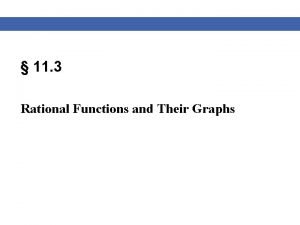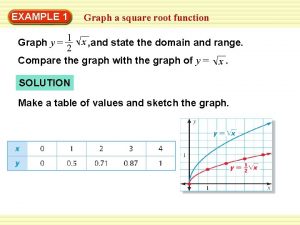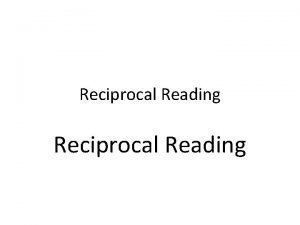The reciprocal function LO Sketch the reciprocal function









- Slides: 9

The reciprocal function LO: Sketch the reciprocal function stating the Domain and Range, equations of Horizontal and Vertical asymptotes.

The reciprocal of a number is 1 divided by that number. For example The reciprocal of 2 1 2 =4 Taking the reciprocal of a fraction turns it upside down

The reciprocal of a number In general: Example: Write as an improper fraction Turn it upside down

The reciprocal function is Where k is a constant Lets draw the graph of the function when k = 1 x -1 f(x) -1 1 -2 -4 4 2 y 1 Notice that the curve gets closer and closer to the x- and y-axes but never touches them. The x- and y-axes form asymptotes. If a curve gets continually closer to a straight line, the straight line is called an asymptote. You can draw a dashed line to indicate the asymptotes. 4 2 1 -1 -½ -¼-1 0 -2 ¼ ½ 1 -4 This is a reciprocal function The graph of a reciprocal function is called a hyperbola. x

The reciprocal function We are going to investigate the effect of changing the value of k. Use your GDC to draw the graph of: What is the effect of changing the value of k The graph is vertical stretched The value of k indicates the scale factor of the vertical stretch

The reciprocal function We are going to investigate the effect of changing the sign of k. Use your GDC to draw the graph of: What is the effect of changing the sign of k The graph is reflected over the x-axis

The graph of y = 4/x Complete the table for x 0. 25 0. 4 0. 5 1 2 4 8 16 10 8 4 2 1 0. 5 0. 4 16 0. 25 What do you notice about the values of x and f(x) in the table? The top and bottom rows of the table contain the same numbers but in reverse order. y 16 14 12 10 8 If we reflect the graph in the line y = x What do you notice? 6 4 2 0 10 2 4 6 8 10 12 14 16 x The function reflects onto itself. What does this tell you about the inverse function? It is a self-inverse function.

The graph of What if we take negative values of x? -16 -10 -8 -4 -2 -1 -0. 5 -0. 4 -0. 25 0. 4 0. 5 1 -0. 25 -0. 4 -0. 5 -1 -2 -4 -8 -10 -16 und 16 10 8 4 What do you notice? 16 The curves get closer and closer to the axes but never actually touch or cross them 12 The axes are asymptotes to the graph 2 4 2 1 0. 5 0. 4 0. 25 8 10 16 y 14 10 8 6 4 2 -16 -14 -12 -10 -8 -6 -4 -2 0 -2 -4 -6 -8 -10 -12 -14 -16 2 4 6 8 10 12 14 16 x

The reciprocal function Summarising: The graph of the reciprocal function is called hyperbola The x-axis is the horizontal asymptote. The y-axis is the vertical asymptote. Both the domain and range are all the real numbers except zero. y = x and y = -x are lines of symmetry for this function The y-axis is an asymptote 4 2 1 -1 The two separate parts of the graph are reflections of each other in y = -x y -½ -¼-1 0 -2 -4 ¼ ½ 1 x The x-axis is an asymptote

















